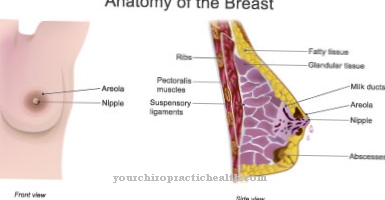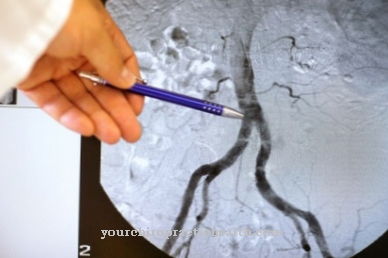At Porphyria it is a summary of various metabolic diseases. Their course is very different. While some diseases cause only mild symptoms, others can be life-threatening. Due to the numerous characteristics, the correct diagnosis is often made late.
What is porphyria?

© Goffkein - stock.adobe.com
Porphyria belongs to the rare diseases. Ultimately, it is based on a disorder that results in the body's inability to produce the protein "heme". However, because the protein takes on important tasks, there are sometimes serious side effects. For example, heme is an important component of the substance that turns human blood red: hemoglobin. In order to be able to produce the protein, there are a number of steps involved.
An enzyme is required for each process. In the context of the disease, however, there is a disorder on at least one level, so that the appropriate enzyme cannot be produced and the following steps are unnecessary. Instead, an accumulation of the precursors of heme, called porphyrins, is created. These are increasingly excreted in the stool and urine. Those affected often only notice the disease from the age of 30 to 40. In general, very few people develop the defect.
causes
The cause of the disease is therefore a defective enzyme. In total, heme is produced in eight stages. If even one is not handled optimally, porphyria develops. Depending on which enzyme is defective, different precursors of the substance accumulate. In addition, several impaired enzymes can be detected in some patients.Two forms of porphyria are considered to be medically relevant: acute intermittent porphyria and chronic hepatic porphyria.
Thus, the disease can be acute or chronic. The acute expression is a disorder of the third enzyme. The body is no longer able to carry out the next steps, which means that the formation of protein at this point comes to a standstill. In the chronic course, the fifth enzyme is defective. Porphyria is inherited in most cases.
Not all those affected suffer from symptoms: a large number of them do not even notice the defect. However, some factors can cause the symptoms by increasing the organism's need for heme. These include smoking, physical stress, estrogen intake, alcohol abuse, and elevated iron levels.
Symptoms, ailments & signs
The symptoms that occur depend largely on whether the disease is acute or chronic. In general, the symptoms vary. Acute porhyria can lead to abdominal pain, nausea and vomiting. Patients report constipation, paresthesia, muscle weakness, sleep problems and depressive moods. The complaints are not always noticeable. Instead, they take the form of flare-ups that manifest themselves at different intervals.
In women, symptoms can be observed to accumulate before menstruation. Furthermore, certain factors contribute to the fact that the symptoms become noticeable. Some medications, infections, and alcohol are responsible for the sudden onset of symptoms. Sensitivity to light is typical for patients with chronic porphyria. The skin reacts with blisters and scarring. In general, the skin is prone to injuries, pigmentation and thicker hair. The chronic course is usually accompanied by other diseases such as diabetes and gastric ulcers.
Diagnosis & course of disease
The diagnosis is usually made by examining the blood as soon as the doctor has a corresponding suspicion through a detailed discussion. The porphyrins and any precursors can be found in the blood. Furthermore, stool and urine samples provide information. Genetic tests are also performed on some patients.
Complications
Due to porphyria, those affected suffer from various complaints, all of which, however, have a negative effect on the quality of life of the affected person. In most cases, however, this disease causes nausea and vomiting. Furthermore, those affected suffer from pain in the abdomen and stomach and also from constipation.
Parasitic sensations or muscle weakness can also occur due to the porphyria and make everyday life more difficult for the patient. Most of those affected continue to suffer from sleep problems or depression. As a rule, the symptoms of porphyria are not permanent, but only appear in episodes. For this reason, an early diagnosis is not possible in many cases, so that the treatment of the disease can only be delayed.
Furthermore, those affected are sensitive to light, so that blisters form on the skin. Stomach ulcers or diabetes can also occur. The treatment of porphyria is carried out with the help of drugs. A liver transplant is also necessary in serious cases. Whether the disease will lead to a reduction in patient life expectancy cannot be universally predicted.
When should you go to the doctor?
As a rule, porphyria should always be treated by a doctor. This disease can extremely limit the life of the person affected and the disease usually does not heal itself. An early diagnosis and treatment have a very positive effect on the further course of the disease and can prevent further complications.
As a rule, a doctor should be consulted in the case of porphyria if the patient suffers from severe abdominal pain or vomiting and nausea. A visit to the doctor is necessary, especially if these symptoms persist. Often, depression or other psychological complaints combined with sleep problems can also indicate the disease and should be investigated. Those affected are often sensitive to light and are not infrequently irritated.
The diagnosis of porphyria can usually be made by an internist or a general practitioner. However, further treatment depends on the exact causes of the disease and is therefore carried out by a specialist doctor. Whether there will be a reduced life expectancy cannot generally be predicted.
Therapy & Treatment
The therapy is primarily based on avoiding all causes of porphyria. For example, women should avoid birth control pills and instead use hormone-free contraception. Other medications that may be responsible for a flare-up should be discontinued or replaced with an alternative, if possible. In order not to cause any damage to health, the exact handling of the medication should be clarified with a doctor.
It is also important that patients try to limit physical and emotional stress. If the course is more severe, however, further measures must be used. Glucose infusions help normalize protein synthesis in the event of an acute attack. If paralysis or other life-threatening symptoms appear due to the disease, the antidote hemarginate can have a supportive effect.
In the chronic course, bloodletting treatment can also provide relief. In this way it is possible to remove an excess of iron. Some patients also respond positively to chloroquine, which actually came on the market as an anti-malarial drug. In extreme cases, acute porphyria calls for a liver transplant. A stem cell transplant is necessary for some chronically ill people. Furthermore, direct sunlight should be avoided, for example by using sun creams with a high sun protection factor.
You can find your medication here
➔ Medicines for muscle weaknessprevention
The disease cannot be prevented. However, there are measures that can prevent flare-ups from occurring. Accordingly, those affected should refrain from alcohol and cigarettes and avoid starvation diets with low calorie intake. In the case of existing infections and other illnesses, a doctor should be consulted quickly so that they subside quickly. If the stress cannot be reduced, at least more relaxation should be integrated into everyday life.
Aftercare
As the disease is often accompanied by depression that requires psychotherapeutic treatment, follow-up care is appropriate. Porphyria usually takes place in relapses and the patient can make an appropriate adjustment to their own life to avoid recurring relapses.
If the liver is affected and already damaged, alcohol should definitely be avoided. Medication may only be taken under medical supervision. A healthy lifestyle can have a positive effect on the disease. Patients should not smoke, exercise a lot, lead a regular everyday life with adequate sleep and eat healthily.
People with porphyria should refrain from strict diets, which can trigger acute attacks, and eat as rich in fiber as possible with lots of vegetables and fresh fruit. Sugar and fats are to be kept as low as possible. Relaxation exercises such as yoga or progressive muscle relaxation according to Jacobson help the patient against possible stress.
With some forms of porphyria, it is important to avoid extreme sunlight in order to prevent a new flare-up. Appropriate clothing and sun creams with a high sun protection factor support this. Regular bloodletting also helps many patients to flush out the porphyrin that has accumulated in the liver.
You can do that yourself
This rare disease is a major psychological burden for the affected patient. They often have a long history of suffering behind them before the diagnosis could be made with certainty. Since depression often accompanies porphyria, additional psychotherapeutic treatment is advisable.
Depending on the clinical picture, all triggers that could cause another flare-up should of course be avoided. If the liver is damaged, alcohol should not be drunk and medication should only be taken after consulting a doctor. Which drugs are allowed and other interesting information can be found on the self-help site EPP Germany (www.epp-deutschland.de). This also applies to people who have another form of porphyria.
In order not to aggravate the disease unnecessarily, those affected should also not smoke, avoid any stress if possible and not take any hormones. Instead, they should make sure they lead a regular life with adequate sleep and plenty of exercise. Relaxation exercises help reduce stress. Yoga and progressive muscle relaxation according to Jacobson are recommended here. Patients with porphyria should not adhere to strict diets, but rather eat as healthy as possible with fresh, fiber-rich food with little fat and sugar. In addition to medical measures, some patients respond well to bloodletting. The idea behind this is to rid the body of excess iron.



.jpg)


-durch-folsuremangel.jpg)




















